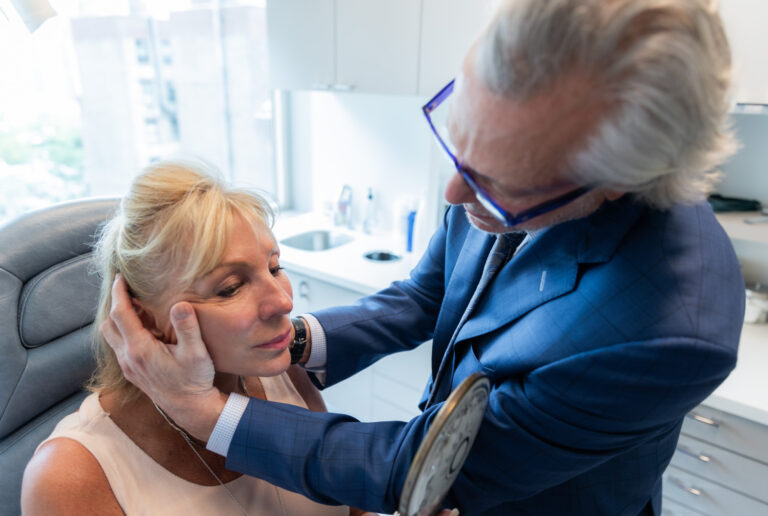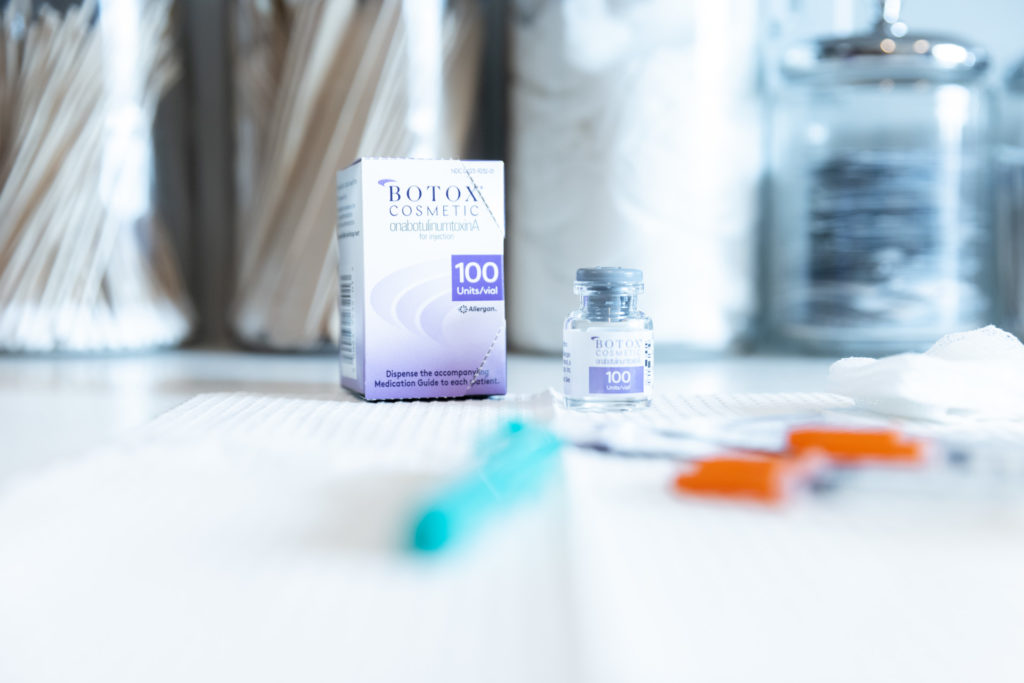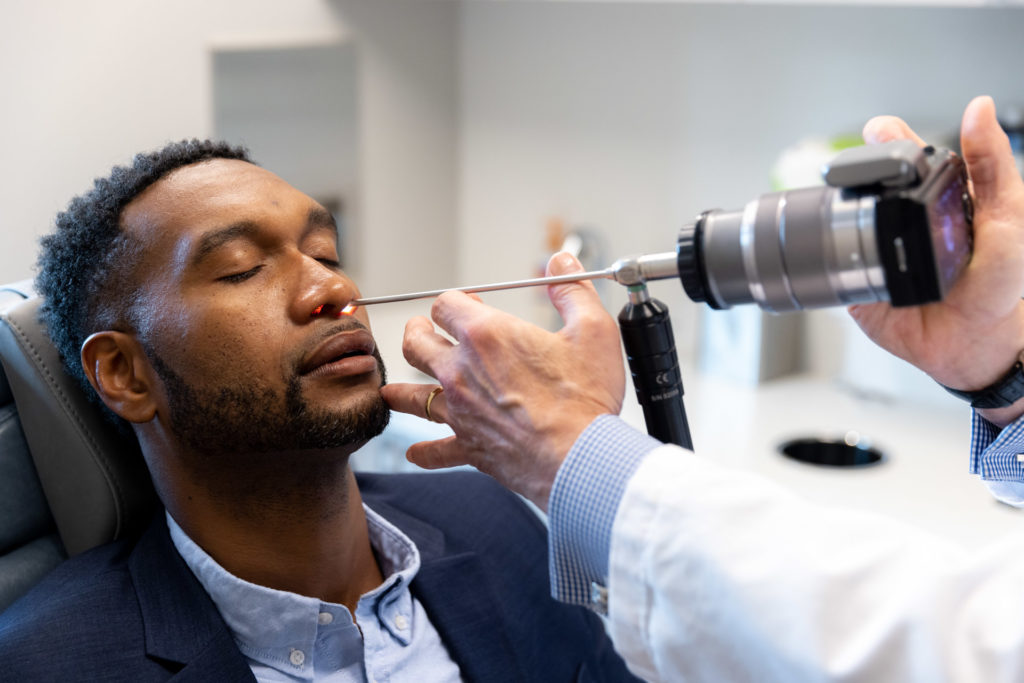
If you’re considering undergoing a rhinoplasty, then you know there is a lot to think about. This is your face we’re talking about! So it’s good that you’re doing your research on the procedure.
There are two different approaches to reshaping the nose: open rhinoplasty and closed rhinoplasty. One of the most confusing dilemmas presented while in the research phase is deciding what technique to use to obtain the best results. It is always good for patients to become well-informed about procedure options so that you can make the right decision about your health and appearance.
That’s why at Pearlman Aesthetic Surgery, we empower our patients to make the most informed decision possible when it comes to open vs closed rhinoplasty. Each technique has its own set of advantages and disadvantages that we encourage you to discuss with Dr. Pearlman before moving forward with your rhinoplasty surgery in New York City.
We will always help you achieve stunning results that work for you. This means educating patients on the treatment options of an open vs closed rhinoplasty and offering expert insight on which rhinoplasty technique would work best for you.
Open vs closed rhinoplasty | Open
At Pearlman Aesthetic Surgery, we perform open rhinoplasty when we feel it is indicated on some of our patients, also referred to as external rhinoplasty, by making a small incision on the columella, the soft tissue that separates the nostrils. This technique allows for easy access to the underlying bone and cartilage structure.
The primary benefit of the open technique is that it allows for improved accuracy in reshaping the framework of the nose to achieve desired contouring. By completely opening the surface of the nose, Dr. Pearlman is afforded more straightforward access to the treatment area, especially for very crooked noses, complex revision rhinoplasty and when unique procedures will be necessary for the nasal tip.
The open technique is best used when considering a revision rhinoplasty because the original structure of the nose has already been disturbed during the original procedure.
Dr. Pearlman may also use the open technique if the patient’s nose is crooked or to achieve a marked reduction in nasal tip projection (how far the tip sticks out from the face). This is because the open technique provides more clear access to the surgical site as well as clarity and ease for intricate suturing and/or grafting.
Scarring from this technique is barely visible and will usually fade with time.
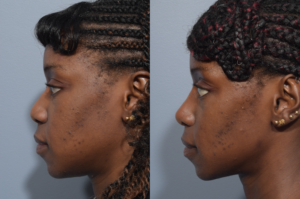
Open vs closed rhinoplasty | Closed
Closed rhinoplasty, also referred to as endonasal rhinoplasty or scarless rhinoplasty, is performed by making all necessary incisions completely hidden within the nostrils.
Dr. Pearlman performs the procedure through separate surgical openings in the left and right nostrils. With no external incisions, the closed technique is less invasive and creates no visible scarring at all.
The lack of the columellar incision (across the bottom of the nose) results in slightly less swelling during recovery and potentially less downtime overall. However, the limited access allowed during a closed rhinoplasty makes manipulation and complex reshaping of the tip of the nose a bit more difficult.
Dr. Pearlman can achieve equal results using a closed approach and an open approach. He uses the closed approach in a little over half of his primary rhinoplasties. He will discuss which technique is best for you during your consultation.
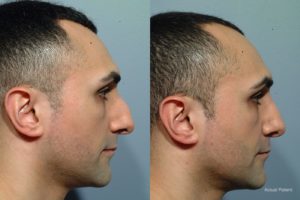
Open vs closed rhinoplasty | Which is best?
The practical difference between the two techniques is small, but the results are important. Without the columellar incision, the closed technique allows for faster operation and less swelling during the recovery period.
On the other hand, an open rhinoplasty allows for more precision for difficult noses and when altering the nasal structures for more complex cases.
You should consider an open rhinoplasty if…
- This will be a revision rhinoplasty
- Your rhinoplasty is particularly complex
- It is necessary to reshape the tip of your nose
- The nose is especially crooked
You should consider a closed rhinoplasty if…
- You’re very concerned about scarring
- You have less time in your schedule for recovery
- Your rhinoplasty is less focused on the tip of the nose
With over 30 years of experience performing well over 7,000 rhinoplasty surgeries, you can rest assured that Dr. Pearlman is an expert in performing both open vs closed rhinoplasty techniques. He’ll discuss with you which approach is best for you during your initial consultation.
Rhinoplasty procedure | A deeper understanding
Now that you have a clearer understanding of open vs closed rhinoplasty, let’s zoom out a little and look at the rhinoplasty procedure as a whole.
A rhinoplasty is a surgical procedure that alters the appearance and/or the function of the nose. We see patients requesting a rhinoplasty for cosmetic purposes or as a solution for breathing difficulties. A rhinoplasty can tackle quite a few treatable concerns such as:
- Nasal hump
- Wide nasal tip
- Drooping nasal tip
- Crooked bridge and/or tip of the nose
- Asymmetrical nostrils
- Bumpiness
- Flat or smoothed appearance of the nose
- Size that is disproportional to the rest of the face
- Deformities from an injury
- Improperly healed broken nose
- Birth defects
- Breathing difficulties
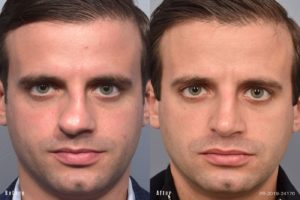
These cosmetic concerns are not simply superficial; feeling uncomfortable with your nose can lead to years of social anxiety, depression, and low self-esteem. At Pearlman Aesthetic Surgery, we understand the toll this can take on someone.
If you’re ready to make the necessary changes to feel outstanding inside and out, then we are by your side for the process. Take a look at our before and after gallery and get excited!
Ideal candidates for rhinoplasty
While we truly understand the power that balanced facial features can have on your overall appearance, and how appearance can affect self-esteem, it is also our job to ensure you are getting the optimal procedure for your desired results. There are a few things we look for that make ideal candidates for rhinoplasty:
- Patients who are healthy and in good physical shape
- Those who do not smoke
- Patients with realistic expectations about the procedure
- Female patients 15+ with complete facial growth
- Male patients 16 + with complete facial growth
Dr. Pearlman will always inform you of the most beneficial option for your unique needs during your initial consultation. If you’d like to learn more about which treatment is best for you, try out our virtual rhinoplasty planning tool! It’s an incredible resource that allows you to get expert advice and treatment recommendations about your rhinoplasty straight to your inbox.
The best rhinoplasty surgeon in NYC
A little bit about Dr. Pearlman
Dr. Pearlman is a world-renowned, dual-board certified facial plastic and reconstructive surgeon in New York City. Over the course of 30+ years, Dr. Pearlman has performed over 7,000 rhinoplasty surgeries, and has helped ensure the confidence of thousands of patients.
His outstanding educational background along with years of experience and a love for the craft make him one of, if not the best, rhinoplasty surgeons in NYC. Dr. Pearlman and his entire team are dedicated to instilling or restoring the self-confidence that allows patients to achieve their goals and be the best version of themselves possible.
This approach means that you will always be seen and heard at our office. Your opinion matters most to us, and we will always do whatever it takes to honor your true beauty on the inside and on the outside.
Listen to Dr. Pearlman discuss revision rhinoplasty and see for yourself why so many people trust him with the future of their face:
How a rhinoplasty works with Dr. Pearlman
In order to familiarize yourself with the entire rhinoplasty procedure, let’s dive a little deeper into the step-by-step process:
Consultation
We begin each and every one of our surgical and non-surgical procedures with an in-depth consultation, during which we will discuss your unique concerns, desired results, and lifestyle factors such as age, general health, and capacity for downtime. This allows us to customize a treatment plan specific to you and your needs.
For a rhinoplasty, the consultation also grants us the opportunity to take a close look at your unique facial features. Dr. Pearlman will do a complete face and nose examination, and will use this opportunity to inform the choices he makes for your surgery, as the approach we use is completely customized to our individual patient’s facial anatomy. He also utilizes computer imaging on all patients to demonstrate and discuss mutual goals for surgery. That’s why we offer these varied and customizable types of rhinoplasty:
- Revision rhinoplasty
- Piezo ultrasonic rhinoplasty
- Ethnic rhinoplasty
- Preservation rhinoplasty
- Teenage rhinoplasty
- Septoplasty/functional nasal surgery
- Non-surgical rhinoplasty
Procedure
Prior to the procedure, Dr. Pearlman will take photos with your consent in order to document the before and after of the procedure. These will not be shared without your written permission.
For the rhinoplasty procedure, we will place you under general anesthesia or twilight sedation. The whole procedure typically takes 1.5 hours to 3 hours to complete. Dr. Pearlman will either perform an open or a closed rhinoplasty procedure, depending on his expert opinion of what’s best for you.
Recovery
The treatment is an outpatient procedure, which means you’ll be able to go home once we clear you after surgery. We’ll be sure to equip you with the necessary pain medication and post-operative care instructions prior to your leaving.
You’ll be groggy and likely a bit uncomfortable, and you’ll be unable to drive yourself, so make sure to arrange for a friend or family member to drive you home.
We typically recommend taking about a week and a half to two weeks off of school or work to recover from your rhinoplasty surgery. You may experience slight pain for the first few days, and the area will be swollen with potential bruising. This is completely normal, and should subside within 1 week. After 10 days, you should be feeling like yourself again.
During your recovery, try to eat healthy whole foods and stay away from processed ones, as they could cause inflammation and worsen the swelling. Be gentle with the area and avoid wearing sunglasses.
Results
You should be able to see the results of your rhinoplasty after just a few weeks, but you’ll achieve optimal results in around 3 months, once the swelling completely subsides.
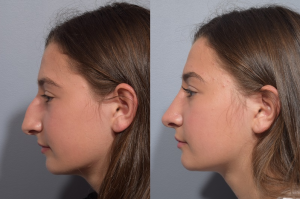
The results of the procedure are permanent! You can expect to enjoy the benefits of your gorgeous new feature for a long time. Patients boast of a completely revitalized appearance, a lessening of social anxiety, a new sense of confidence, and higher self-esteem!
Commonly asked questions about rhinoplasty
When is a good age to have a rhinoplasty?
As long as you are in good health and have realistic expectations, you can undergo a rhinoplasty at any time in your adult life! We do offer rhinoplasty for teens with parental consent and following an in-depth consultation process.
Is rhinoplasty scarring noticeable?
In the hands of an experienced and highly skilled surgeon, your incision scars from either an open or a closed rhinoplasty should be hardly visible at all.
Will people be able to tell I’ve had a nose job?
The answer to this question depends on what you’d like to get out of the rhinoplasty. Many patients desire a dramatic change that may be noticeable to close friends or family members.
This is simply because their previous nose wasn’t in alignment with their other facial features, and those friends and family members may find that the new iteration of your nose fits your face even better.
Others desire a subtle enhancement to their features. The goal with this type of enhancement is to leave friends wondering what new makeup or hair style you must be using to look so revitalized.
Regardless, your results will not come across as “plastic” or “overdone.” Dr. Pearlman is excellent at ensuring that your new feature fits perfectly to your facial balance in a way that looks completely natural.
Do you break the bones in the nose during rhinoplasty?
Sometimes osteotomies are necessary. In some cases, we may carefully cut and reset the bones to achieve the desired shape and profile we discussed during your consultation. Osteotomies do not increase post-op pain, hinder healing, or affect the strength of the nose once healed.
We also may use more modern techniques such as Piezo ultrasonic powered rhinoplasty or preservation rhinoplasty during your procedure to avoid osteotomies as well if necessary.
Try our virtual rhinoplasty tool!
If you’re considering a rhinoplasty, we’ve got just the tool for you. Try our online rhinoplasty planning tool. It’s an incredible resource that allows you to get expert advice and treatment recommendations about your rhinoplasty straight to your inbox.
For more information on the best rhinoplasty NYC has to offer, or to set up a consultation with double board-certified facial plastic surgeon Dr. Steven J. Pearlman, contact our office at 212-223-8300.


